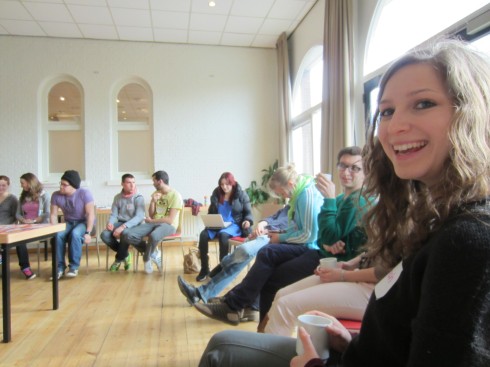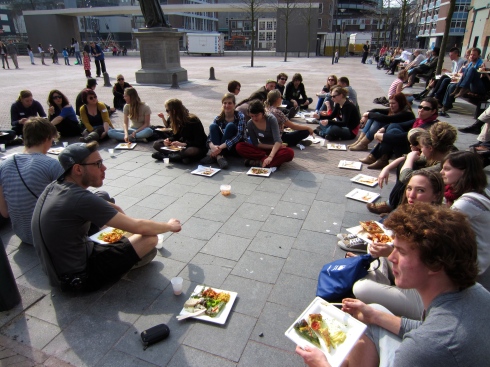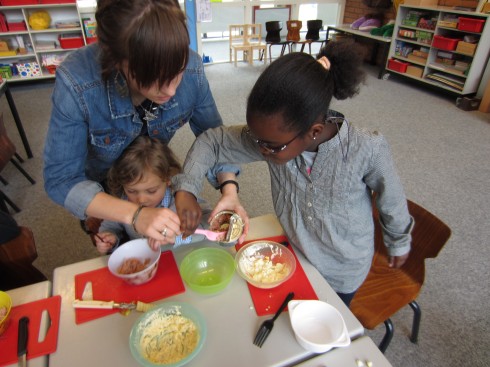So what’s your fieldwork about?
I’m following the activities of European Voluntary Service volunteers as they participate in six different community-building projects in the South Rotterdam suburb of Feijenoord.
And what are you going to do with that?
I’m trying to get an in-depth volunteer perspective on EVS, in order to develop a bottom-up understanding of how active citizenship and participatory democracy might work in practice.
Confused yet? Researchers and academics always struggle to condense their projects into a couple of chewable sentences. Luckily in a blog post (or two), I have a little more room to expand.
What’s EVS?
Look it up. Ha. No, but seriously there is a lot of information online. Yet surprisingly few young Europeans I chat to between the ages of 18-30 know about this opportunity. There’s some promotional stuff (e.g. Europe on the Move, The European Year of Volunteering), but visibility seems to be an issue. Many ‘EVS-ers’ know about EVS through someone else, like a friend or family member.
EVS is part of the European Commission’s ‘Youth In Action’ programme, and through it any young European can spend 2-12 months volunteering in a country (usually European) other than their own. They get a food/living allowance, trainings, accommodation, and travel allowance. Basically, it’s Europe’s answer to the Peace Corps, albeit a more regionally focused version.
EVS volunteers work for European non-profit organisations on projects based on over 40 diverse themes such as social inclusion, development, youth policies, European awareness, anti-discrimination, environment, gender equality, health, children, minorities, art and culture, and human rights.
In theory, they pick the theme they want to work on and the country they go to. In reality, they often need to be persistent and apply to a range of organisations in a variety of countries before they secure one of the 6,500 annual placements.
EVS Trainings
The main part of EVS is the volunteer placement. But EVS also encompasses three or four trainings. I’ve attended all of them except the Pre-Departure training, which happens in the country of origin.
At trainings, volunteers:
- meet other EVS-ers
- get information about how EVS works
- present their own projects and learn about other EVS projects
- have time for sharing and reflection
- learn about Dutch culture and society
The trainings are:
On Arrival training, 5 days. Run by the National Agency in the country in which you volunteer.
Mid Term training, 3 days. Halfway through your volunteer project, again run by the National Agency
Evaluation training, 1 day. When you return home.
At the On Arrival training in Apeldoorn, 9 volunteers from all over Europe (Romania, Czech Republic, Germany, Spain, Latvia, France, Italy, Armenia) drew road maps of their journey to get to where they are now. They talked about Dutch culture, and designed their own project about Dutch society and culture. One group chose to investigate traditional Dutch food habits, and another Dutch values. They went out into the community in Apeldoorn and interviewed Dutch people to get information for their projects.
Another volunteer from a different group told me that at her On Arrival training, they dressed up some of the guys in women’s clothing and secretly filmed Dutch peoples reactions, to observe Dutch ‘tolerance’ (or lack of) in action.
At the Mid Term in Den Haag, the theme was ‘Looking Back’. This was time for the 24 participants to share and reflect on EVS so far, both practically and emotionally. It also involved a deeper look at other aspects of Dutch culture. And volunteers were encouraged to think about what kinds of competencies they are developing through their EVS, and how they may develop them even further.
The Evaluation training incorporated 55 participants from the Netherlands, Belgium and Luxembourg. Participants reflected on the EVS experience in terms of what it represented in their lives, how it changed them, and how they can or do use it now. Ex EVS-ers also spent time brainstorming on how to make EVS more visible to European youth, to spread the word about this opportunity.
The really major thing about trainings that all the EVS-ers remember is the people they met and the friendships they formed: it’s a hive for meeting new kinds of people or, as they would say in policy speak, developing ‘intercultural dialogue’.
EVS Aims
The EVS is part of the Youth in Action programme, a program which has received 885 million euros of funding between 2007-2013. So why does the European Commission fund EVS?
Well, if we look at the Commission website, it’s because they want to develop youth into active European citizens and foster social cohesion/inclusion.
The EVS is a promoted as a mutually benefical learning service, with a strong European and intercultural dimension.
What does this mean? Volunteer Simon put it this way:
The aims of EVS. For sure it’s to, it’s a small step, for sure, but it’s in order to create a…European youth, I guess, to create a youth that is quite interested in European….things, and that have not only a nationality perspective in their mind. And I guess it’s also in order to promote another way of learning than usual learning with schools.
because the good idea about EVS, the really good idea is that its open to absolutely everybody, you don’t have to have any diploma, to have any knowledge, to have any skill, at the beginning. So it’s a way of learning. It’s a way of doing something, and it’s a way of learning a lot of things, in a new country and a new environment. And this point for sure, it’s a way of being included in society, and in a European society. So yeah, it can really be quite big for a young guy with absolutely no perspective at the beginning.
Politicising Volunteering
Obviously though, when volunteering becomes a policy aim, we can ask more political questions. This is particularly the case when it is linked as it is in this case to active citizenship, which has already drawn analytical attention (see for example Rose 1999, Newman and Tonkens 2011).
With cuts in funding for many social and community services in European member states, are EVS-ers filling the gaps in European social welfare provision? Are EVS projects a way to pawn responsibility off onto Europe’s citizens for their own welfare, or to make non-profit organisations, often with minimal funding and resources, shoulder the burden instead of government? Or are non-profits indeed becoming a new form of government, using government funding to improve and transform society in various ways (see Eliasoph 2011)?
Can EVS volunteers function as short-term, flexibilised workers who breeze in and out of communities without much thought for the impact they make, or what will happen when they go? Are they only there for their own personal development, for their own ‘experience’ living in another culture and another country?
If so, there may be potentially harmful consequences for the communities they work with and the recipients of their volunteer efforts, especially if these are already disadvantaged or marginalised groups. Projects can also be disadvantageous for the volunteer, or for the non-profit organisation (for example if a volunteer decides to quit halfway through).
This is, of course, in the worst-case scenario. Most of the time it really depends on the volunteer and the organisation. This is a good thing when it goes well: EVS can be creative, innovative and fresh. However, there is room for it to be volatile, unpredictable and disorganised.
In my fieldwork on the EVS, I’ve been lucky to see a really good example of how EVS can be a success. I see the change this experience is making in the lives of volunteers, and the importance of their presence for socioeconomically disadvantaged communities in South Rotterdam. I also see that all the organisations do their best to address social issues and provide much needed support in the community, especially the hosting organisation, Lava Legato.
But although I’m not sure of the answers, the hard questions still need to be asked. The global voluntary sector (if we can call it that) is a huge jumble of commerical, non-commerical, government, non-government, voluntary, non-voluntary, providers and organisations. What is needed is some critical and analytical attention to the form and content of this sector, the people who set the agenda behind it, and the people on the front lines, namely, the volunteers.
When voluntary service starts to be promoted by political institutions we have to ask, what is the aim of all this promotion of volunteering? Who benefits from the EVS experience: the volunteer, the recipients, the community, the organisations, or the Commission? What happens when volunteering is used for a range of different ends? And are all those ends always in the best interests of the communities with which the volunteers work, or indeed of the volunteers themselves?
And why has volunteering been so strongly linked to the concept of ‘youth’ in the European Union? What kind of youth are included in this conceptualisation of the young European active citizen, and what kind are excluded?
EVS as Alternative Future?
If we are talking about Europe’s future, what is Europe moving toward? The future looks less and less bright for many in wake of the GFC and more recent Europe-specific economic crises. The announcement of the new Erasmus for All programe to replace the Youth in Action programme has done little to allay the concerns of European youth and organisations who see this as a way to further cut down on youth spending through the centralisation of a number of youth programs. The European Youth Forum has responded with a campaign emphasising the rights of youth to a properly funded Youth programme.
So, European youth, just like everyone else appears to be in the current global climate, are worried. They don’t want to see funding cut; they don’t want to lose opportunities; and perhaps even more so than before, programmes like the EVS provide them with a viable alternative to trying to scrape a place in the increasing shrinking labour market, while at the same time gaining some skills. Many find it a great way to travel and experience a different culture and language. They also meet all kinds of people they have never met before, ranging from the people in the culture and society of the country they live in, to the communities they work with, to the other EVS-ers they meet, who come from all over Europe and beyond.
So in this way, EVS is something they want to see expanded and promoted. Whether or not EVS is wholly positive, whether or not it still has kinks to be ironed out, it definitely has its advocates. Maybe EVS can really be an avenue for youth to make a difference and become the new, empowered, active generation. Maybe we are witnessing the seeds of European participatory society and democracy.
But whether EVS does expand or morph into something else remains to be decided by the powers that be in May 2012.
So now I’ve introduced you to EVS. In Part 2 of this post, I’m going to take a closer look at how EVS works in the South Rotterdam suburb of Feijenoord. Stay tuned…









Leave a comment